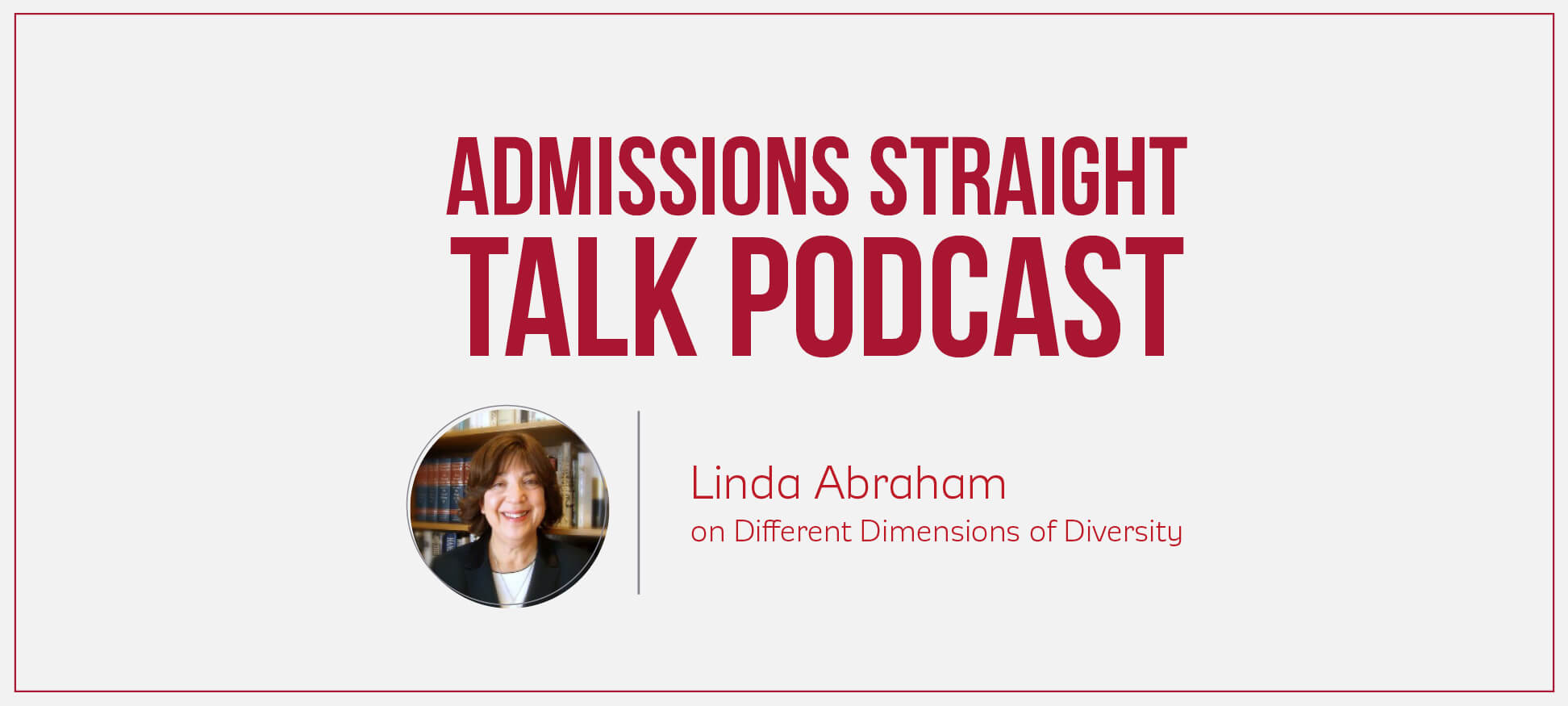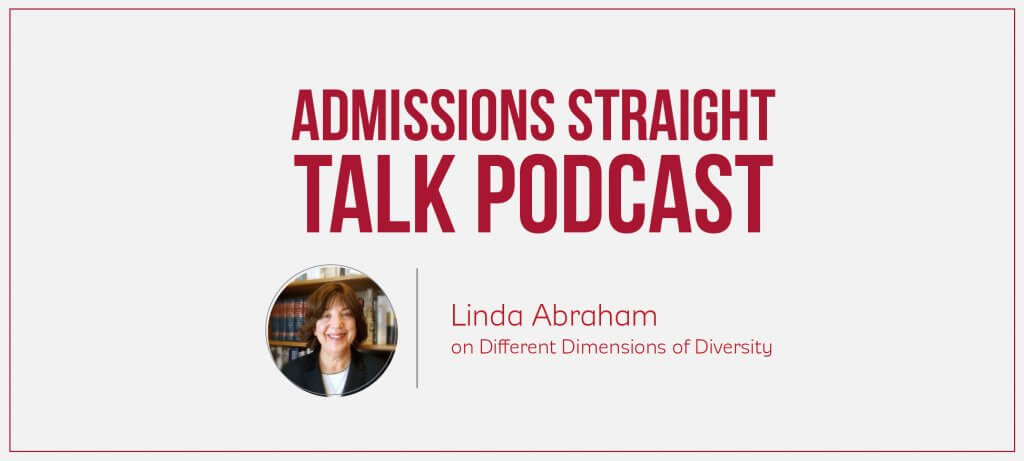|
Different Dimensions of Diversity |
||
Different Dimensions of Diversity

In reviewing our stats for last year, I noticed that one of our most visited pages is an article on writing about diversity. That’s not shocking since Accepted’s consultants are frequently asked by stressed, panicked clients from well-represented groups in the applicant pool, “How can I answer this diversity question?!?!” Given the high interest in the topic, not to mention the anxiety associated with it and the confusion surrounding it, I decided to discuss it today and go into more depth than we can in a blog post.
So here are the questions I’ll answer on today’s show:
1. Why is diversity important?
2. How can you approach diversity?
3. How can you write about diversity?
I’m covering a lot in the show. To help guide you, we’ve created a Dimensions of Diversity Checklist for you to download.
1. Why is diversity important?
Two primary reasons:
• The more diverse perspectives in a class room, the richer the discussions in class, in study groups, and the more creative the teams on projects. The more exposure all members of a class or team have to varied approaches and perspectives, the more prepared they will be for working in a multi-cultural society and world. Admissions offices believe that diversity in the classroom improves the educational experience of all students.
• American society, and indeed many societies, are increasingly heterogeneous. The world is more global and multi-cultural. Many professions and employers want a diverse work force. Medicine recognizes that a heterogeneous work force benefits people from cultures heretofore under-represented in medicine. Businesses realize that they will market more effectively if they can speak to different audiences and markets. Schools simply want to prepare graduates for the twenty first century job market.
2. How can you approach diversity?
I’m so glad you asked! There are so many ways! Really an infinite number of ways. But I’ve broken them down into three primary categories, and I’ll provide a bunch of examples for each one.
First the three-part framework:
1. Identity: who you are
2. Deeds: what you’ve done
3. Ideas: how you think
As we go through these categories, you’ll quickly realize that there is overlap in the framework. The three topics are not mutually exclusive, and you may argue with how I classified some of my suggestions. That’s fine, and the framework isn’t the point. The purpose of the framework is just to get you thinking more broadly about diversity and how you can show it.
I. Your Identity.
This is the most common way that people think of diversity, and it certainly is a valid one in admissions. The under-represented minority applying to many top graduate schools almost by definition is showing diversity, but again let’s think more broadly about identity and showing diversity. Here are several ideas:
• Under-represented minority. In a U.S. context: African American, Hispanic American, and Native American.
• Ethnicity. This includes applicants coming from a country or culture not well represented. Not just under-represented minorities.
• Religious commitment. For example, the Buddhist monk at ISB.
• Non-traditional educational background. Here, think of the music major applying to medical school, or the bio major going for a masters in management, or the engineer deciding to go for a PsyD. Please note that the diversity element doesn’t relieve you of the need to meet academic requirements and fulfill prerequisites!
• Non-traditional work experience. The MSW or software engineer who wants to become a physician. The premed who decides entrepreneurship is her calling and applies to b-school. The actor who decides to go into law.
• Disability. Living with/overcoming disability is difficult. How has it strengthened you?
• Multi-cultural background. Perhaps your parents, like mine, came from two different countries and their native languages were different, such that English was the language in your home and when relatives came to visit it was hard to find a language that everyone could understand. Or maybe you grew up interpreting for members of your family.
• Gender or sexual orientation. Are you a woman in engineering? A male in a traditionally female occupation?
• First member of family to attend college. You parents, like mine who did not attend college, may have been very supportive of your attending college, but not as familiar with the system as parents who had been through it. There are also parents who didn’t attend college and perhaps can’t afford to support their offspring’s efforts or simply don’t value education because they’ve been productive without college. Again, a different experience and perspective.
II. Your Deeds.
• Accomplishments. This is a great way to distinguish yourself, but if you are applying to highly competitive programs, it may also be the most difficult way because everyone is accomplished and achievements in your field and in academics are more a ticket of entry than a diversity point. However, accomplishments outside the field you’re aiming for (and in addition to those in your field), those are gold.
• Overcoming challenges. Challenges come in many forms and we all deal with them, but there are little challenges and big ones. I’m talking about the big ones. The life derailing ones that really throw you for a loop. What happened? How did you deal? How did you grow? What did you learn? How will these lessons guide you in the future?
• Leadership experiences. Leadership with impact is absolute gold in admissions. Now in some fields it is more common so you may say it is not diversity factor, but if your leadership experience is unusual, then it still may qualify.
• Community service. There are so many ways to contribute to your community and so many ways to define community that your specific experience has to be unique. Focus on the singular aspects of that experience and how you changed and your perspective changed as a result of this experience.
• Military leadership. This implies significant responsibility frequently in dangerous situations where lives, assets, and relationships are at stake. The military also teaches team work and logistics. Write about your military experience in terms of the values and lessons that translate to civilian life.
• Professional or internship experience. Increasingly important for all professional schools (relevant research for research-oriented programs). Above average promotions and growth in responsibilities is what admissions offices want to see. They also want to see that you made a difference and contributed to your office, group, team, or lab.
• Other distinguishers include unique hobbies, research, athletics/sports, teamwork skills, travel, or even the fact that you worked your way through college.
III. Your Ideas.
Are you an innovator? An ideas person? Do you tend to approach things differently and creatively? A problem solver? Or perhaps you are driven by a particular philosophy or theology? All these are examples of the way you think and how your approach to situations, problems, opportunities… or life will be distinctive and could provide diversity to a school, community, or class discussion. Here are a few examples of how your ideas could contribute to diversity:
• Background in big data.
• Ability to look at details and see a bigger picture.
• Specific philosophy or perspective.
• Qualitative analysis.
• Off the wall ideas that on closer examination look feasible and maybe even great.
• Problem solver.
• The person who finds the element of humor that dissolves tension in group settings.
• The person who finds common ground in contentious situations. A bridge builder.
• Perhaps an approach that blends the liberal arts and the sciences – narrative medicine, musical engineers, etc.
I realize I’ve given you a lot of possibilities here. At the same time I also know this list isn’t exhaustive. Yes, Virginia, there are still other ways to show diversity that I haven’t mentioned, but the ones I’ve mentioned are a good starting point. We’ve also created a checklist, which will make it easy for you to review the suggestions I’ve made and of course add your own. Click here to get your checklist.
So once you download the checklist you’ll have 30+ different ways to think about diversity to jump-start your creative engines. Let’s turn now to writing about diversity.
3. How to Write About Diversity
Some schools may ask you to discuss how you think of diversity. Others may ask how you will bring or add to the diversity of their school, your community, or your chosen profession. Whatever is asked, make sure that you answer the question, and that your response highlights the distinctive hue that you will add to the class mosaic every admissions committee is creating.
A possible approach to a diversity question: Define diversity in the way that will be easiest for you to address the topic and answer the specific prompt. Then provide 1-3 examples, specifics, or anecdotes that show how you represent that form of diversity.
I’ve emphasized the importance of specifics, but as important as examples are, they are insufficient for a great diversity essay. You also need analysis.
Balance the anecdote with analysis that ties your experience to the program you are applying to, its values, and its mission and perhaps your goals or simply your best answer to the question posed. The analysis can consist of lessons learned, changes in your thoughts on diversity, an evolution in your approach to similar challenges, or some other way to show growth. It will frequently go in the conclusion of your essay.
I hope you find these thoughts helpful in writing your diversity essay. Remember to download the free checklist so that you can have the diversity ideas in front of you when you sit down to write your diversity essay.
Related Links:
• Dimensions of Diversity Checklist
• Approaching The Diversity Essay Question
• Overrepresented MBA Applicants and Business School Diversity
• Med School Admissions Advice for Nontraditional Applicants: The Experts Speak
• 5 Fatal Flaws to Avoid in Your Grad School Personal Statement
Related Shows:
• Focus on Fit [Episode 162]
• Stand Out! A Critical Goal for Your Application [Episode 181]
• D.O.s for Diversity: Ashley’s Osteopathic Med School Journey
Subscribe:
The post Different Dimensions of Diversity [Episode 193] appeared first on Accepted Admissions Blog.




[0] Comments to this Article